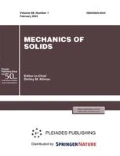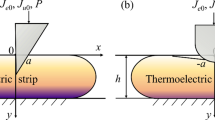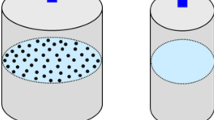Abstract
In the present paper, we use the finite element method to perform the three-dimensional modeling of unsteady process of cutting an elastoplastic plate (slab) by an absolutely rigid cutting tool moving at a constant velocity V 0 at different inclinations α of the tool face (Fig. 1). The modeling was based on the coupled thermomechanical model of an elastoviscoplastic material. The adiabatic process of cutting was compared with the regime in which the slab material heat conduction is taken into account. The cutting process was parametrically studied for variations in the slab and cutting tool geometry, in the rate and depth of cutting, and in the properties of the processed material. The slab thickness was varied in the direction of the axis z. The stressed state varied from the plane-stressed \( \bar H \) = H/L≪ 1 (thin plate) to the plane-strained \( \bar H \) ≫ 1 (wide plate), where H is the slab thickness and L is the slab length. The problem was solved on a moving adaptive Lagrange-Euler grid by the finite element method with splitting, by using the explicit-implicit integration schemes for equations [13]. It was shown that the numerical modeling of the problem in the three-dimensional statement permits studying the cutting processes with continuous chip formation and with chip destruction into separate pieces. The mechanism of this phenomenon in the case of orthogonal cutting (α = 0) can be explained by the thermal softening with formation of adiabatic shear strips without using the damage models. In cutting by a sharper tool (the angle α is large), it is necessary to use the coupled model of thermal and structural softening. We obtain dependences of the force acting on the tool for different geometric and physical parameters of the problem. We also show that the quasimonotone and oscillating operation modes are possible and explain them from the physical standpoint.
Similar content being viewed by others
References
M. E. Merchant, “Mechanics of the Metal Cutting Process. I. Orthogonal Cutting,” J. Appl. Phys. 16, 267–275 (1945); “II. Plasticity Conductions in Orthogonal Cutting,” J. Appl. Phys. 16, 318–324 (1945).
R. Hill, The Mathematical Theory of Plasticity (Oxford, Clarendon Press, 1950; Gostekhizdat, Moscow, 1956).
M. C. Shaw, “A Quantized Theory of Strain Hardening as Applied Cutting of Metals,” J. Appl. Phys. 21(6), 599–606 (1950).
M. C. Shaw, Metal Cutting Principles (Oxford Sci. Publ., New York, 1986).
K. Liu and S. N. Melkote, “Material Strengthening Mechanisms and Their Contribution to Size Effect in Micro-Cutting,” Trans. ASME J. Manufact. Sci. and Eng-ng 128(3), 730–738 (2006).
H. Miguelez, R. Zaera, A. Rusinek, et al., “A Numerical Modeling of Orthogonal Cutting: Influence of Cutting Conductions and Separation Criterion,” J. Phys. IV France 34, 417–422 (2006).
M. Baker, “Does Chip Formation Minimize the Energy?” Comput. Mat. Sci. 33, 407–418 (2005).
E. Sakino, “Transition in Rate Controlling Mechanics of FFC Metal at Very High Strain Rates and High Temperatures,” J. Phys. IV France 10, 57–64 (2000).
G. I. Kanel, S. V. Razorenov, and V. E. Fortov, “Shock-Wave Compression and Tension of Solids at Elevated Temperatures: Superheated Crystal States, Pre-Melting, and Anomalous Growth of the Yield Strength,” J. Phys. Condens. Matter. 16(14), S1007-S1016 (2004).
G. Maenchen and S. Sack, “The “Tensor” Code,” in Methods Comput. Phys., Vol. 3 (Acad. Press, New York, 1964), pp. 188–210.
V. M. Fomin, A. I. Gulidov, G. A. Sapozhnikov, et al., High-Speed Interaction of Bodies (Izd-vo SO RAN, Novosibirsk, 1999) [in Russian].
N. G. Burago and V. N. Kukudzhanov, Numerical Solution of Continual Fracture Problems Preprint No. 746, IPMekh RAN (Inst. for Problems in Mechanics RAS, Moscow, 2004) [in Russian].
V. N. Kukudzhanov, “Decomposition Method for Elastoplastic Equations,” Izv. Akad. Nauk. Mekh. Tverd. Tela, No. 1, 98–108 (2004) [Mech. Solids (Engl. Transl.) 39 (1), 73–80 (2004)].
V. N. Kukudzhanov, A. L. Levitin, and V. S. Sinyuk, “Numerical-Analytical Splitting Method for Modeling Quasi-Static Processes of Strain of Damaged Materials,” in Applied Problems of Strength and Plasticity. Mezh. VUZov. Sb., No. 68 (Nizhnii Novgorod, 2006), pp. 7–21 [in Russian].
V. N. Kukudzhanov, “Coupled Models of Elastoplasticity and Damage and Their Integration,” Izv. Akad. Nauk. Mekh. Tverd. Tela, No. 6, 103–135 (2006) [Mech. Solids (Engl. Transl.) 37 (6), 83–109 (2006)].
N. Aravas, “On the Numerical Integration of a Class of Pressure-Dependent Plasticity Models,” Intern. J. Numer. Methods in Eng-ing 24(7), 1395–1416 (1987).
G. R. Johnson and W. H. Cook, “A Constitutive Model and Data for Metals Subjected to Large Strains, High Strain Rates and High Temperatures,” in Proc. 7th Intern. Symp. Ballistics (1983), pp. 541–547.
B. A. Boly and J. H. Weiner, Theory of Thermal Stresses (Wiley, New York, 1960; Mir, Moscow, 1964).
Author information
Authors and Affiliations
Corresponding author
Additional information
Original Russian Text © V.N. Kukudzhanov, A.L. Levitin, 2008, published in Izvestiya Akademii Nauk. Mekhanika Tverdogo Tela, 2008, No. 3, pp. 208–216.
About this article
Cite this article
Kukudzhanov, V.N., Levitin, A.L. Numerical modeling of cutting processes for elastoplastic materials in 3D-statement. Mech. Solids 43, 494–501 (2008). https://doi.org/10.3103/S0025654408030205
Received:
Published:
Issue Date:
DOI: https://doi.org/10.3103/S0025654408030205




